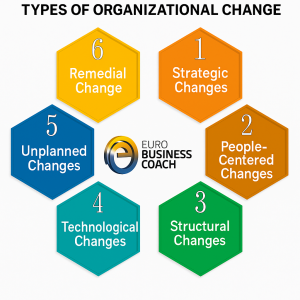
Claudia Nieto Licht
May 6, 2025
In an increasingly dynamic and competitive environment, effectively managing organizational change is more than a necessity; it is a strategic competence for sustainability. According to John P. Kotter, leadership and change expert, 70% of organizational change processes fail due to a lack of human focus, strategic clarity, or weak implementation.
At Euro Business Coach, we understand that organizational change is not an event, but a process that transforms both structural and human capital. Organizations that thrive are those that strategically align these two pillars, developing internal capabilities and generating sustainable value.
Organizational change management is a systematic approach to transition from the current state to a desired state, with the goal of improving performance, culture, and results. It involves methodologies, tools, and personalized support to facilitate the adaptation of people and structures to strategic transformations.
Christensen and Overdorf note that an organization must develop new capabilities—not only technological or structural, but also human—in order to sustain organizational change.
Not all changes are the same. Before designing a strategy, it is essential to:
Why is this step so important? Because a poorly focused organizational change can generate more resistance than progress.
A recent Harvard Business Review article identifies six strategic levers that increase the likelihood of success in organizational change processes:
These levers not only facilitate implementation but also strengthen collective belonging and shared purpose.
At Euro Business Coach, we identify six common types of organizational change, each with its own particularities. Understanding these differences allows for better adaptation of strategies:
Seeks to create competitive advantage. Includes business model reorientation, redesign of the value proposition, or expansion into new markets.
Suggested model: Kotter’s 8-Step Change Model – ideal for aligning vision, leadership, and action.
Directly impacts employees: internal policies, well-being, culture, or new ways of working.
Suggested models: Kübler-Ross Change Curve for managing emotions and the Satir Change Model to facilitate emotional transition.
Involves modifications to hierarchies, teams, functions, or organizational structures.
Suggested model: Lewin’s Change Model (Unfreeze – Change – Refreeze), useful for operational transitions.
Adoption of digital tools, automation, or implementation of collaborative platforms. Includes upskilling and reskillingprocesses.
Keys to success: continuous training, technical support, and digital leadership.
Changes triggered by external events, such as a health crisis or economic disruption. Require agility and adaptability.
Suggested model: ADKAR (Awareness, Desire, Knowledge, Ability, Reinforcement), effective for quickly activating organizational response.
Reactive in nature, it aims to solve existing problems in culture, processes, performance, or work climate.
Key: act quickly but with a clear diagnosis—avoid “firefighting” without systemic solutions.
Each type requires a different management model, but all must be grounded in the human factor as the basis for successful organizational change.

Resistance to organizational change is a natural response to uncertainty. People may fear losing control, status, or competencies. This aversion to change, if not managed properly, can paralyze any initiative.
Some effective strategies include:
Leadership is fundamental. A present, coherent, and approachable leader can reduce anxiety and transform resistance into commitment during organizational change.
One of the greatest assets of an organization undergoing change is its capacity for continuous learning. According to Peter Senge, “learning organizations” are those that promote learning at all levels to proactively adapt to their environment.
How to foster a learning culture?
A learning organization does not just survive organizational change: it leads it, capitalizes on it, and turns it into a competitive advantage.
Managing organizational change is not just about implementing something new, but about preparing, supporting, and sustaining so that change translates into sustainable results.
At Euro Business Coach we help you to:
👉 Schedule a free consultation with our experts and discover how we can support your next organizational changeprocess.
📩 Visit us at euro-businesscoach.com or contact us today.
Transforming your organization through effective organizational change is possible—with the right partner by your side.
If your organization is undergoing change, wants to manage the next process effectively, or has questions about this essential topic in today’s organizations, do not hesitate to contact us. At Euro Business Coach, we have the expertise to support you through these organizational change processes. Consult us!





At Euro Business Coach, we support individuals, teams, and organizations in growing with purpose.
Our experience in consulting, coaching, and training allows us to offer comprehensive solutions that strengthen talent, optimize management, and connect strategy with action.
We work with a practical and human-centered vision to generate lasting changes that bring real value to companies, their employees, and their environment. We believe in conscious development, meaningful innovation, and results that leave a lasting impact.
© Euro Business Coach. All rights reserved.
Funded by the European Union – NextGenerationEU. However, the views and opinions expressed are solely those of the author(s) and do not necessarily reflect those of the European Union or the European Commission. Neither the European Union nor the European Commission can be held responsible for them.